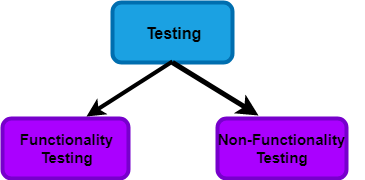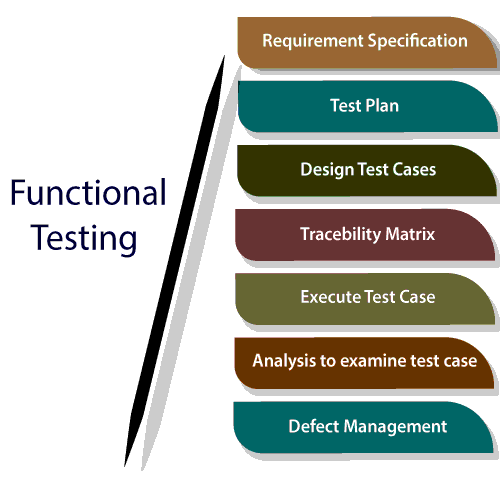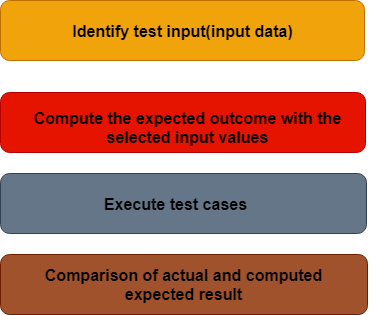Before proceeding to functional testing, we should know about the testing, what testing is?
What is testing?
In simple terms, the testing is to compare the actual result with the expected result. Testing is done to identify whether all the function is working as expectations.
What is Software Testing?
Software testing is a technique to check whether the actual result matches the expected result and to ensure that the software has not any defect or bug.
Software testing ensures that the application has not any defect or the requirement is missing to the actual need. Either manual or automation testing can do software testing.
Software testing also defines as verification of application under test (AUT).
There are two types of testing:

Functional Testing:
It is a type of software testing which is used to verify the functionality of the software application, whether the function is working according to the requirement specification. In functional testing, each function tested by giving the value, determining the output, and verifying the actual output with the expected value. Functional testing performed as black-box testing which is presented to confirm that the functionality of an application or system behaves as we are expecting. It is done to verify the functionality of the application.
Functional testing also called as black-box testing, because it focuses on application specification rather than actual code. Tester has to test only the program rather than the system.
Goal of functional testing
The purpose of the functional testing is to check the primary entry function, necessarily usable function, the flow of screen GUI. Functional testing displays the error message so that the user can easily navigate throughout the application.
What is the process of functional testing?
Testers follow the following steps in the functional testing:
- Tester does verification of the requirement specification in the software application.
- After analysis, the requirement specification tester will make a plan.
- After planning the tests, the tester will design the test case.
- After designing the test, case tester will make a document of the traceability matrix.
- The tester will execute the test case design.
- Analysis of the coverage to examine the covered testing area of the application.
- Defect management should do to manage defect resolving.

What to test in functional testing? Explain
The main objective of functional testing is checking the functionality of the software system. It concentrates on:
- Basic Usability: Functional Testing involves the usability testing of the system. It checks whether a user can navigate freely without any difficulty through screens.
- Accessibility: Functional testing test the accessibility of the function.
- Mainline function: It focuses on testing the main feature.
- Error Condition: Functional testing is used to check the error condition. It checks whether the error message displayed.
Explain the complete process to perform functional testing.
There are the following steps to perform functional testing:
- There is a need to understand the software requirement.
- Identify test input data
- Compute the expected outcome with the selected input values.
- Execute test cases
- Comparison between the actual and the computed result

Explain the types of functional testing.
The main objective of functional testing is to test the functionality of the component.
Functional testing is divided into multiple parts.
Here are the following types of functional testing.

Unit Testing: Unit testing is a type of software testing, where the individual unit or component of the software tested. Unit testing, examine the different part of the application, by unit testing functional testing also done, because unit testing ensures each module is working correctly.
The developer does unit testing. Unit testing is done in the development phase of the application.
Smoke Testing: Functional testing by smoke testing. Smoke testing includes only the basic (feature) functionality of the system. Smoke testing is known as "Build Verification Testing." Smoke testing aims to ensure that the most important function work.
For example, Smoke testing verifies that the application launches successfully will check that GUI is responsive.
Sanity Testing: Sanity testing involves the entire high-level business scenario is working correctly. Sanity testing is done to check the functionality/bugs fixed. Sanity testing is little advance than smoke testing.
For example, login is working fine; all the buttons are working correctly; after clicking on the button navigation of the page is done or not.
Regression Testing: This type of testing concentrate to make sure that the code changes should not side effect the existing functionality of the system. Regression testing specifies when bug arises in the system after fixing the bug, regression testing concentrate on that all parts are working or not. Regression testing focuses on is there any impact on the system.
Integration Testing: Integration testing combined individual units and tested as a group. The purpose of this testing is to expose the faults in the interaction between the integrated units.
Developers and testers perform integration testing.White box testing: White box testing is known as Clear Box testing, code-based testing, structural testing, extensive testing, and glass box testing, transparent box testing. It is a software testing method in which the internal structure/design/ implementation tested known to the tester.
The white box testing needs the analysis of the internal structure of the component or system.
Black box testing: It is also known as behavioral testing. In this testing, the internal structure/ design/ implementation not known to the tester. This type of testing is functional testing. Why we called this type of testing is black-box testing, in this testing tester, can't see the internal code.
For example, A tester without the knowledge of the internal structures of a website tests the web pages by using the web browser providing input and verifying the output against the expected outcome.
User acceptance testing: It is a type of testing performed by the client to certify the system according to requirement. The final phase of testing is user acceptance testing before releasing the software to the market or production environment. UAT is a kind of black-box testing where two or more end-users will involve.
Retesting: Retesting is a type of testing performed to check the test cases that were unsuccessful in the final execution are successfully pass after the defects fixed. Usually, tester assigns the bug when they find it while testing the product or its component. The bug allocated to a developer, and he fixes it. After fixing, the bug is assigned to a tester for its verification. This testing is known as retesting.
Database Testing: Database testing is a type of testing which checks the schema, tables, triggers, etc. of the database under test. Database testing may involve creating complex queries to load/stress test the database and check its responsiveness. It checks the data integrity and consistency.
Example: let us consider a banking application whereby a user makes a transaction. Now from database testing following, things are important. They are:
- Application store the transaction information in the application database and displays them correctly to the user.
- No information lost in this process
- The application does not keep partially performed or aborted operation information.
- The user information is not allowed individuals to access by the
Ad-hoc testing: Ad-hoc testing is an informal testing type whose aim is to break the system. This type of software testing is unplanned activity. It does not follow any test design to create the test cases. Ad-hoc testing is done randomly on any part of the application; it does not support any structured way of testing.
Recovery Testing: Recovery testing is used to define how well an application can recover from crashes, hardware failure, and other problems. The purpose of recovery testing is to verify the system's ability to recover from testing points of failure.
Static Testing: Static testing is a software testing technique by which we can check the defects in software without actually executing it. Static testing is done to avoid errors in the early stage of the development as it is easier to find failure in the early stages. Static testing used to detect the mistakes that may not found in dynamic testing.
Why we use static testing?
Static testing helps to find the error in the early stages. With the help of static testing, this will reduce the development timescales. It reduces the testing cost and time. Static testing also used for development productivity.
Component Testing: Component Testing is also a type of software testing in which testing is performed on each component separately without integrating with other parts. Component testing is also a type of black-box testing. Component testing also referred to as Unit testing, program testing, or module testing.
Grey Box Testing: Grey Box Testing defined as a combination of both white box and black-box testing. Grey Box testing is a testing technique which performed with limited information about the internal functionality of the system.

What are the functional testing tools?
The functional testing can also be executed by various apart from manual testing. These tools simplify the process of testing and help to get accurate and useful results.
It is one of the significant and top-priority based techniques which were decided and specified before the development process.
The tools used for
functional testing are:
|
Tools |
Features/ Characteristics |
|
Sahi |
|
|
SoapUI |
|
|
Watir |
|
|
Selenium |
|
|
|
|
Canoo WebTest |
|
|
Cucumber |
|
What are the advantages of Functional
Testing?
Advantages of functional testing are:
- It produces a defect-free
product.
- It ensures that the customer
is satisfied.
- It ensures that all
requirements met.
- It ensures the proper working
of all the functionality of an application/software/product.
- It ensures that the software/
product work as expected.
- It ensures security and
safety.
- It improves the quality of the
product.
Example: Here, we are giving an example of banking software. In
a bank when money transferred from bank A to bank B. And the bank B does not
receive the correct amount, the fee is applied, or the money not converted into
the correct currency, or incorrect transfer or bank A does not receive
statement advice from bank B that the payment has received. These issues are
critical and can be avoided by proper functional testing.
What are the disadvantages of functional
testing?
Disadvantages of functional testing are:
- Functional testing can miss a
critical and logical error in the system.
- This testing is not a
guarantee of the software to go live.
- The possibility of conducting
redundant testing is high in functional testing.
Wrap Up
Here, we can easily conclude that to build a strong foundation
of a top-class software product, functional testing is essential. It acts as a
foundation of the structure, and it is a crucial part of every test routine.



0 Comments